| Home
News
Overview
Diary
Statistics
In Deutsch
MAIL

|
- Pictures of our Yemen trip – with
our car from May 16th to June 15th, 1996
- (During our circumnavigation of the Arabian
Peninsula – from Oman to Saudi Arabia)
-
- the following without our vehicle in February 2011:
- Part 1: Socotra Island trip in Yemen
(East) –
Hadibo - Dihamri - Arher Beach
- Part 2: Socotra Island trip in Yemen
(South) – Homhil - Aomak Beach - Wadi Daerhu - Dicksam Plateau
- Part 3: Socotra Island trip in Yemen
(West) – Qalansiya - Shouab Beach - Qadama Beach - Momi Plateau - Wadi Ayhaft
- Part 4: United Arab Emirates – Sharjah - Dubai
-
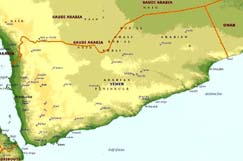
-
- Yemen Map
|

-
-
- Map of the Arabian Peninsula
|
click a picture
to see details |

|
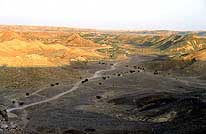
|
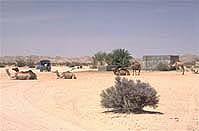
|
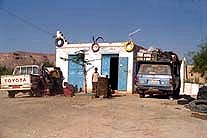
|
- Crossing the Rub' al Khali,
- the largest sand desert of the
- world on the Yemeni side
|
- Desert spring near Thamud
|
- Tire shop in Tarim, Hadramawt Valley
|
-
-
- Yemen, splendor of 1001-nights (May 16, 1996 – June
15, 1996)
-
- The bearded young man with his shouldered Kalashnikov is examining us suspiciously when
we reach his control post at the edge of the Rub al Khali desert with our adventurously
equipped Toyota LandCruiser. Arriving through a labyrinth of desert tracks from Oman, it
is our entry into the Hadramawt Valley, from the empty desert back into civilization. With
his two saddled camels, he is the officer in charge that nobody undesirably is entering
his beautiful country. And he really takes his mission very seriously and checks our
paperwork carefully. After a few minutes however, he already waves us into the legendary
Arabia Felix.
The first mosque is appearing between the white desert sand and the dry wadi. We are
approaching the small village of Qasam. The brown color of the simple adobe dwellings is
matching perfectly with the bare brown desert mountains. Their elaborate colorful doors
lead into a secluded yard, where behind high protecting walls life is going on as it did
for centuries. Farmers are watering their lush green fields nearby with an ingenious
irrigation system. The wheel of time has been standing still in this remote part of the
world.
|
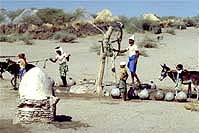
|
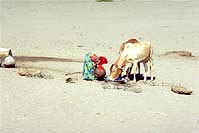
|
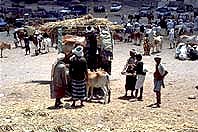
|
- Biblical scenes between Thamud and Tarim
|
-
-
- On a dusty track, we penetrate further into the heart of this fascinating valley.
Between long stretched villages at the foot of vertically towering mountain walls, the
white domes of Marabouts – the tombs of holy men – are gleaming in the desert
sun. Along the barren track, we pass red glowing fires of limestone ovens, fed with camel
dung and old tires, pushing a black trail of smoke towards the sky. They are burning the
lime that traditionally is used for the adornment of the house facades that give the
Yemeni architecture its outstanding unique appearance. Producing lime powder in the
murderous heat is not at all a bed of roses. Carried from the surrounding mountains, it
has to be heated up to 14 hours at over 1800°F degrees, and it takes the same time to
cool it down again. This procedure softens the limestone, which is then crushed into
powder – a very strenuous work!
|
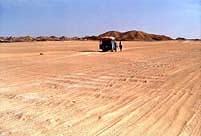
|
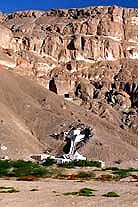
|
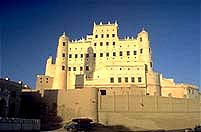
|
- Rub’-al-Khali desert from
- Oman to Yemen
|
- Al-Muhajir tomb near
- Sayun, Hadramawt Valley
|
- Sultan Al Kathiri Palace in Sayun,
- Hadramawt Valley
|
-
-
- The first major place Sayun is dominated by the impressive sultan’s palace and the
shiny dome of the Al Habshi tomb. We urgently need Yemeni Rial currency and are looking
around in the small main square. Immediately, we find ourselves surrounded by a lively,
oriental scene. With fascination, we watch the bargaining of these bearded men. Suddenly,
we are attracted by excited loud voices. We hardly can believe what we see: An elderly
money changer is sitting in the midst of piles of Rial bundles on an old fashioned
pushcart. First, we are a bit suspicious about the legality, but then we change some
dollars without any problems and head straight to a small restaurant consisting of three
long benches. We order freshly baked warm pita bread, smashed peas and liver and pay,
including five soft drinks, not more than 3 US$! Eating out makes fun again!
|
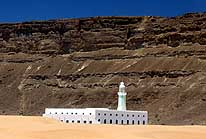
|
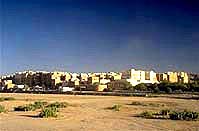
|
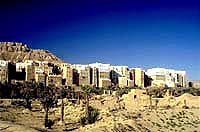
|
- Mosque in the desert / Hadramawt Valley
|
- Shibam - ‘Manhattan of the Desert’,
- Hadramawt Valley
|
- Shibam - ‘Manhattan of the Desert’,
- Hadramawt Valley
|
-
-
- Already before sunrise, we have breakfast in the dry wadi with a splendid view to the
legendary Shibam – called the “Manhattan of the Desert” and UNESCO world
heritage site, where we camped the night. Here it is especially obvious that the
architects of the past were tending to build skywards in order to protect themselves
against possible attackers. The adobe strongholds were six to eight stories high and did
adapt wonderfully into the landscape. They stand very close to one another, resembling a
fortified island in the desert. Now and then, a deeply veiled woman scurries past us;
goats rummage in the piles of garbage lying around as we wander through the narrow alleys
in the early morning, where in ancient time’s camel caravans rested. From small
wooden windows, curious children are watching us. At one of the already opened tourist
shops, old doors, preciously carved, are for sale. In front of some of the doorways, there
are shelters made of dry palm leaves and pieces of colorful tissues to protect the animals
from the scorching sun. Next day, when we say good-bye to this unique city, we cannot
resist the impression that probably not too many people are still living in these more and
more crumbling “skyscrapers of the desert”.
|
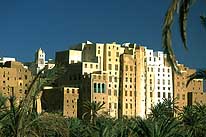
|
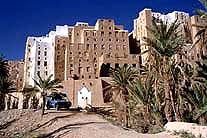
|
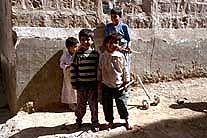
|
- Shibam - ‘Manhattan of the Desert’,
- Hadramawt Valley
|
- Skyscraper city of Shibam,
- Hadramawt Valley
|
- Yemeni children in Sana’a
|
-
-
- By leaving behind the stunning Hadramawt Valley with its vertically eroded mountain
walls and its beautiful scenery, we leave behind also its picture-book villages. As a
special treat, on our way out we encounter veiled women in black long robes and
cone-shaped straw huts, their outfit known to be typical for this region. They are sitting
on an antique oxcart and are heading to their scattered cornfields.
When we reach the tropical climate of the Gulf of Aden’s coastal region, we are
plunging into another fascinating world. Mukhalla, the harbor town that was badly hit by
the war between North and South Yemen, is a picturesque place nestling at the foot of
rugged desert mountains and a half-moon shaped bay with a white sandy beach. It shows a
mixture of Yemeni, Indian and Asian architecture, and at its heyday it must have looked
splendidly. Today, the ancient treasures are fading away, and at a closer look, negligence
and garbage cannot be ignored. The next day we are on our way to the Southwest. Until Bir
Ali, we drive along a coast with secluded beaches and a sea shining in all variations of
blue and green on one side and pitch black volcano rocks with white sand collars on the
other side, followed by perfectly shaped volcano cones and frozen lave fields stretching
down to the sea. Now and then, we pass an armored war relict rusting away as a testimony
of the bloody war fought two years ago. Starting from Ar Rawdah, the scenery is getting
more and more mountainous and wilder. It is a region of rugged beauty that takes our
breath away. The air is still and heavy when we look for a place to set up a camp amidst
the black hot rocks. As soon as we park, crowds of biting flies give us a hard time.
Luckily, we are taught only much later of another inconvenience: The forgotten mines still
lying around in this region! We prepare our main meal of the day: Three minute-noodles and
cheese. Then we crawl into our car and kill the time sweating awake until dawn.
|
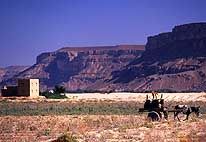
|
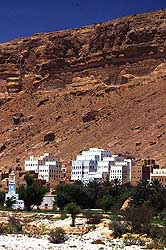
|
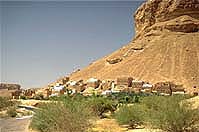
|
- Women in the black Abaya and with the
- Nakhl (straw hat) leaving for the fields
|
- Wadi Al-Ayn, Hadramawt Valley
|
- Wadi Al-Ayn, Hadramawt Valley
|
-
-
- After an almost sleepless night, we are not in the slightest mood to continue further
South towards Aden, where the temperatures are even more disturbing. Is there any
alternative road? We study our guide book carefully and read about a new road that is not
yet marked on any map we carry with us. It begins after the village of Mukayras. Shortly
afterwards, we find ourselves climbing on a sealed and well developed road in many
spectacular hairpins to an elevation of over 6500ft. with awesome views to the huge dry
valley below that is interrupted by small mountain ridges only. Finally, we are able to
breathe some fresher air and recover from the unbearable heat of the plains. Driving
further, at some point near Al Bayda, we leave the former South Yemen and are immediately
swept away by the traditional outfit of the bearded men of the Northern tribes. It is
especially their precious dagger strapped at their waist, their shouldered Kalashnikov and
the broad ammunition belt that gives them their unique wild and adventurous appearance. We
find it shows some similarities with Balochistan in Pakistan.
Branching off at Dhamar on another new road in South Eastern direction towards Hammam Damt
- Qatabah - Marif, we reenter South Yemen once more – the differences between the
North and the South are amazing: The population gets sparse, ancient draw wells replace
the modern water tap system of the North, the villages become less attractive and
unfinished. At a control post, local taxis and good transporters have to pay toll; they do
not bother us though.
|
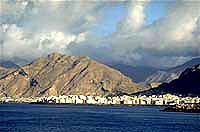
|
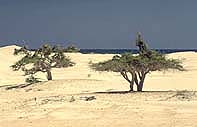
|
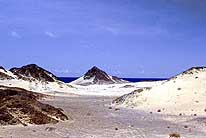
|
- Bay of Al-Mukhalla,
- 300 miles East of Aden
|
- Sand dunes along the sea at Bir Ali
|
- Desert and the sea near Bir Ali
|
-
-
- Then, we are approaching Tai’zz, the former, second Yemeni capital (after Zabid),
nestled at the foot of the steep and 9860ft. high mountain Sabir, which has no vegetation
at all. From the hillside at the Marib Hotel we enjoy a marvelous view down to the old
city with its narrow alleys and the tall minarets of the big mosques. Dusk is approaching
and we are anxiously looking for a spot to set up camp. We cannot yet judge the security
situation in this wild country and therefore are glad to find a place on a plateau of a
tiny mountain ridge, away from the populated area. In the refreshing evening breeze,
suddenly huge black centipedes are crawling out of flowering cacti scrub. Only when we
change to our sturdy walking shoes, we feel comfortable again.
But the surprising encounters are not yet over. Suddenly three young men step out of the
dark, one of them carrying a Kalashnikov. The trio sits down to the ground besides our car
despite of the everywhere crawling centipedes. Unfortunately, our late visitors speak only
Arabic, the reason why we cannot communicate at all. When the armed guy never stops
scanning our fully loaded LandCruiser with his torch, we get more nervous by the minute.
Plenty of time passes and they do not make the slightest attempt to leave. With signs, we
try to explain them that we are tired and want to go to sleep. Surprisingly, they seem to
understand and disappear unexpectedly. As soon as we are alone again, we just have one
urge: To get away from here. Who guarantees us that their current visit was merely a
friendly one, but that during the night they might return on a less peaceful mission? We
find for the rest of the night a place near a disturbingly noisy street – but at
least without visitors.
|
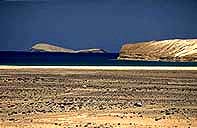
|
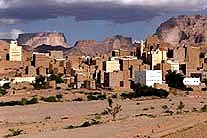
|
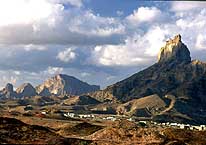
|
- Coastal scenery at Bir Ali,
- West of Mukhalla
|
- Sunset atmosphere over Ar-Rawdah
|
- Mountains in the Ar-Rawdah region
|
-
-
- We continue now towards the current capital: Sana’a. The terraced surrounding
becomes lush green, with Qat being the main crop, whose delicate leaves generate a
stimulating effect and are of great social importance to the people. On mountain ridges,
the typically Yemeni “aerie” villages are becoming more frequent. On a good,
well developed road, we are climbing up to 9186ft. altitude to the Sumahra Pass. Many
times, we are forced to stop to let cool down the car’s water and oil temperatures
– the radiator is causing us increasingly headaches. Each time we stop along this
tourist route, we are immediately surrounded by begging children, asking for money in
particular. They are very persistent and throw stones after us, if we do not comply with
their request.
And then, at an elevation of 7220ft., we reach the climatically pleasant capital of
Sana’a with its unique architecture, belonging also to the world heritage sites. As
legend has it, this town was founded by Noah’s son. It is an exciting feeling
wandering through the chaotic, exotic and lively old city where dilapidated LandCruisers,
scrap taxis, overloaded pickups, rattling handcarts, antiquated donkey and oxcarts and a
huge crowd of people in traditional dresses are pushing their way simultaneously through
narrow alleys. The strange smells and the lively atmosphere occupy all our senses and the
richly and beautifully adorned houses’ architecture attracts us like a magnet. We
discover always new fascinating corners with views over minarets, tiny green vegetable
gardens and palm groves. In ancient times, the old city was the residential quarter for
the rich. They left in the meantime the narrow dusty alleys for better open land. The
poorer moved in who do not have the financial means to maintain their homes. UNESCO is now
caring for its conservation. We were told that the common Yemeni custom of carrying always
a gun doesn’t apply to Sana’a.
|
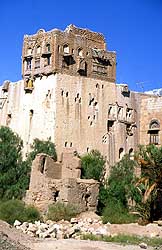
|
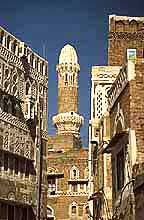
|
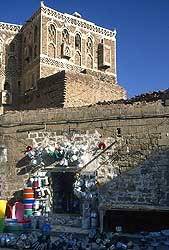
|
- Rada
|
- Minaret in the old town
- of Sana'a
|
- Kettle shop in the
- old town of Sana'a
|
-
-
- From the 5th floor of the Golden Daar Hotel and from the 8th floor of the Old
Sana’a Palace Hotel, we overlook the entire splendor from a bird’s view. But
when our eyes catch the ground, we are also confronted with a less romantic part of this
country: Garbage is piling up everywhere despite that a kind of garbage removal exists. We
watch some women carrying their rubbish to a nearby truck where it is scanned once more by
other people for things they might be able to use. The big poverty is shocking. According
to statistics, the average life expectancy of a Yemeni in 1990 was only 52 years (2008 =
63). This doesn’t really surprise us considering the poor hygienic conditions of
life. And without any doubt, the daily Qat consumption is also paying its toll. Nothing is
functioning without this stimulating leaves, the afternoon hours being the main part of
the day for chewing it. During this time, business is only progressing extremely slowly.
We are told that the daily money spent in Qat is around US$40; US$3 by the poor and US$10
by the better off. B.t.w.: Recently, Qat leaves have been added to the drug list in
Switzerland, despite that the Yemeni want to persuade us of its harmlessness: Qat is
clearing the brain and help to overcome tiredness, we are told. Qat does neither help to
forget nor to solve problems but to talk about them. During a Qat gathering many deals are
sealed too.
While in earlier times a small fountain highlighted the entrance of the famous city gate
– the 1000-year old Bab Al-Yemen – nowadays casual laborers with archaic tools
are looking for an opportunity to earn some money. The adjoining market place is crammed,
and the produce is diverse and sufficient. Mounds of carefully piled up ripe tomatoes,
carrots, cucumbers, potatoes, zucchinis, onion, garlic and other vegetables – nothing
is missing. The most eye-catching are the artistically arranged dates with burning incense
sticks in between to keep away the omnipresent, bothersome flies.
|
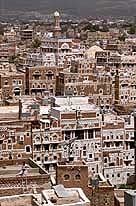
|
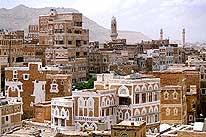
|
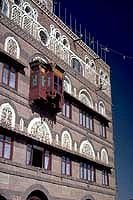
|
- Fascinating architecture
- in Sana’a (pop. 2.5 mio.)
|
- View of Sana’a, capital of Yemen,
- at an altitude of 7'220 ft.
|
- Traditional house facade
- with oriel in Sana’a
|
-
-
- One day, we are invited at the Ministry of Youth for a press conference. On our way to
their offices, we suddenly find ourselves in the middle of a close shooting spray. Sirens
of ambulances howl through the streets. At windows, some curious heads appear wondering
what is happening. It is a tribal conflict fought with the government that is erupting
from time to time, we are told. Apparently, the mountain people retry to seize some land
that has been promised to them. They are positioned on a high mountain ridge and are
shooting from there down into city ground. The counter part, armed police and military,
rushed in with flak. In the shortest of time, order is reinstalled and the planned
occupation is foiled. People do not really seem to be worried about this skirmish. They
are used to this kind of dispute. As we learn, the Presidents Palace is built even
underground for security reasons.
|

|
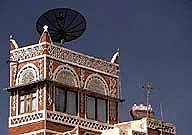
|
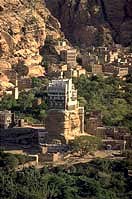
|
- Traditional house facade
- in Sana’a
|
- Tradition and modern times in Sana’a
- (foreign TV programs are tempting)
|
- Wadi Dhahr with rock palace
- 10 miles North of Sana'a
|
-
-
- Through lucky circumstances, we are invited by a Yemeni family – Emil to a Qat
gathering, and me to a traditional women’s get-together. In the Arab world, men and
women attend events strictly apart, unless it is a close family affair.
On my arrival, my host, dressed in a modern outfit, gives me a heartedly welcome. Her two
little girls wear festive, king blue dresses with white laces. We enter a long, narrow
room where the whole floor is covered with a red carpet. Comfortable, colorful cushions
are the major ornament. The only “furniture” is a polished and intricately
studded brass plate with three big water pipes on it. The room is on the first floor and
has five spacious windows giving view to a busy souk lane of the old city.
Slowly the deeply veiled women arrive wearing their floor-length black Tchadors. From the
moment they take off their “topcoat”, they turn out to look like princesses of
1001-night. They wear long dresses of heavy fabrics, richly decorated with golden
embroideries, headbands of brocade, thin silk stockings and a decent make-up. Cups of
fresh aromatic tea are constantly served on a huge tablet, followed by bowls loaded with
selected sweet pastry, raisins, almonds, pistachio-nuts and candies. The young girls are
happily sitting together, exchanging their little secrets with chatter and laughter. The
older generation is busy with the latest gossip and talk animatedly through the whole
afternoon while smoking the water pipe and chewing Qat that they take out of a personal
paper bag. Leaf after leaf of this drug is stuffed into their mouth until their cheeks
look like those of a hamster. Now and then they take a little sip of water or Cola to
intensify the stimulating effect. I have the chance to try the Qat leaves too: They taste
bitter like almonds.
To welcome a guest with a cloud of fragrance is a very old tradition. The host is holding
a clay pot with burning extracts, beautifully smelling, close to the hair and the dresses,
leaving behind a long lasting scent. Spraying the guests with an exquisite perfume is
another of their traditions. Does a dance performance also belong to their hospitality? I
watch with amazement, as two young girls start to dance to the music of a cassette
recorder the traditional, threepart Sana’a dance. It consists of many different
little steps, done mostly on the spot. For me it is the culmination of a special and
unforgettable afternoon.
|

|
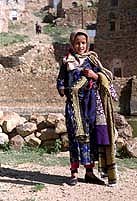
|
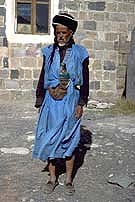
|
- Rock palace Wadi Dhahr
|
- Girl of Thula
- (Kawkaban/Shibam region)
|
- Yemeni with traditional
- ceremonial dagger (Jambiya)
|
-
-
- Power cuts are common in Sana’a. One evening, we are sitting under a canopy of
glowing stars by candle light on the roof terrace of the Swiss Honorary Consul and get to
learn more about this conservative Arab country. There is a huge water shortage in the
capital. The water level sinks yearly 20ft. and the government talks about that
Sana’a could become the first capital in the world, which is running dry. The costs
of a desalination plant in the port city of Hodeidah would arise to US$10 for 1000 liters
of water. We also talk about the regime: The many Yemeni tribes cannot identify themselves
properly with their parliament, with the result that all decisions turn out to be just a
compromise. And we talk also about car theft: A member of the German DED organization lost
three cars within 18 months.
When at 4am the voices of the Muezzin echo from far and near calling for prayer, our
feeling for this strange world is very intense and overwhelming. We love to have a base in
this lively city and start to make some day trips into the surroundings, firstly to the
beautiful rock palace Dar Al Hajjar, towering above the green Wadi Dhar framed by high
walls of rocks. It is a piece of perfect beauty and one of the most breathtaking examples
of the unique Yemeni architecture.
Another day, we drive into the mountains, where the mountain village life seems almost
unchanged for centuries. Thula with its two still intact watch towers and its compact
fortress wall at the foot of a huge mountain massive is especially interesting. A big
water cistern is the centre of the village life, where people and animal get together and
where overloaded thin donkeys are walking past.
|
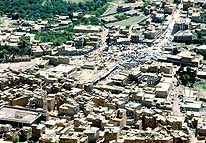
|
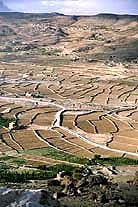
|
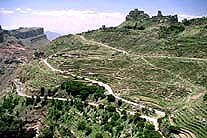
|
- View from Kawkaban towards
- Shibam village, West of Sana'a
|
- Terrace fields in the Hajjah
- region after harvesting
|
- Terrace fields in the Hajjah region,
- Northwest of Sana'a
|
-
-
- In many hair-pin bends, a good tarmac road, built by the Germans in 1993, leads us
deeper into the mountains. Again and again we are captured by the incredibly beautiful
views of the terraced fields below us that are cleaved to steep mountain slopes. Every
single inch of land is cultivated. The small hamlets along the road are in such conformity
with its environment, that it is hard to detect them. At noon, we reach the village of At
Tawilah, sitting next to two huge boulders, its souk showing lovely stone arcades. It is
such a pity that garbage is piling up everywhere. A funeral procession is just ploughing
its way through a dirty alley. The busy market life is almost over. Only the Qat vendors
are still present. Very soon even they will be gone and life comes to a complete stand
still for the next hours – it is Qat time, time for us to head back to Sana’a.
To visit Marib, the former kingdom of the legendary Queen of Saba, with an armed guide, is
not tempting us at all. And without protection it is simply too dangerous. Tourists are
still attacked or kidnapped on this road. Therefore, we content ourselves with a visit to
Hajjah, where once more beautiful panoramas open up to us: On each mountain ridge, on each
outcrop, on each peak, bastions and fortified villages are rising into the sky –
their accumulation being typical of the Yemeni highland and interior. View points are in
abundance along this road. But we cannot really appreciate them, because whenever we stop
to take in the scenery, we are besieged without exception by money asking youngsters. In
earlier times, many mountain villages were only accessible by strenuous donkey paths.
Today, the new road, built by the Chinese, reaches also Hajjah.
|
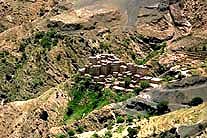
|
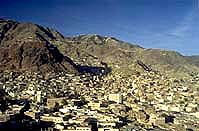
|
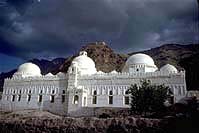
|
- Mountain village in the Hajjah region
- in the Washha Mountain Range
|
- View of Ta'izz, the second biggest
- town in Yemen (pop. 600'000)
|
- Thunderstorm approaching
- a tomb near Ta'izz
|
-
-
- The Southeast monsoon is already approaching, when we leave Sana’a after 17 days
and decide to push on to Aden despite to expect an infernal heat. A different world is
opening up the more to the South we advance: The rugged mountain give way to a desert with
sand dunes, the first palm trees and adobe houses emerge, and approaching Aden, the
typical Soviet apartment buildings are taking over. Their desolate condition is
demoralizing and, at a closer look, it is even more depressing. A lot is dilapidated,
bombarded houses are not removed or restored yet, the decay is visible all around.
Everything needs to be taken care of. But the setting could not be lovelier: Laying at the
foot of an extinct volcano and surrounded by secluded sandy beaches amidst black lava and
bizarre rock formations – it is an awesome sight. People of different races have
settled down here. Many live in poverty und are sleeping on the soft sand on the beach, on
cobble stone alleys, in wrecked cars, on rooftops or anywhere under the sky. But may be it
is due to the unimaginable heat only?
When we leave Aden through the causeway, the whole surrounding is covered in a thick cloud
of haze. After a terribly sticky night in the car we are more than happy to escape this
hellish heat and are heading to the last sector of our Yemeni journey – towards
Hodeidah in the Tihama plain. It is African life pure that is expecting us there: Round
huts made of straw, goat kraals, dark-skinned people, unveiled women in colorful dresses,
men without daggers and Kalashnikovs: It has nothing in common anymore with the
traditional Highland-Yemen. As we are heading towards the Saudi Arabian border, we know
with certitude that we will be dreaming for a very long time of this fascinating country
– our 93rd – with its deep-rooted traditions.
Note: Today – beginning of 2009 and 69 countries later – we still believe
that Yemen is one of the most interesting destination of the world.
|
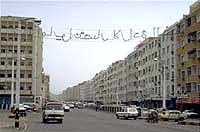
|
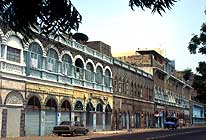
|
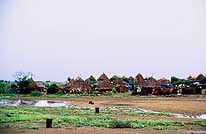
|
- Main road in Aden, the capital of the
- former People's Democratic Republic of
- Yemen, built according to the Soviet style
|
- Facade in Aden from
- the English colonial time
|
- Roundhuts in the Tihamah
- coastal region, near Zabid
|
-
|
More websites
from Yemen, where we visited in February 2011 the Island of Socotra: (without
our vehicle)
- Part 1: Socotra Island trip in Yemen
(East) –
Hadibo - Dihamri - Arher Beach
- Part 2: Socotra Island trip in Yemen
(South) – Homhil - Aomak Beach - Wadi Daerhu - Dicksam Plateau
- Part 3: Socotra Island trip in Yemen
(West) – Qalansiya - Shouab Beach - Qadama Beach - Momi Plateau - Wadi Ayhaft
- Part 4: United Arab Emirates – Sharjah - Dubai
|
|
![]()















































